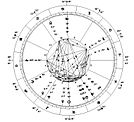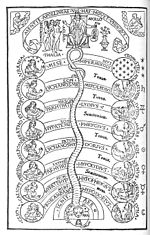- Musica universalis
-
"Music of the spheres" redirects here. For other uses, see Music of the spheres (disambiguation).
Astrology Background History of astrology Astrology & astronomy Sidereal vs. Tropical Traditions Babylonian · Hellenistic Islamic · Western Hindu · Chinese More... Branches Natal astrology Electional astrology Horary astrology Mundane astrology More... Categories Astrologers Organizations Astrological texts Astrological writers Astrology Portal Musica universalis (lit. universal music, or music of the spheres) is an ancient philosophical concept that regards proportions in the movements of celestial bodies—the Sun, Moon, and planets—as a form of musica (the Medieval Latin name for music). This 'music' is not usually thought to be literally audible, but a harmonic and/or mathematical and/or religious concept. The idea continued to appeal to thinkers about music until the end of the Renaissance, influencing scholars of many kinds, including humanists.
Contents
History
The Music of the Spheres incorporates the metaphysical principle that mathematical relationships express qualities or ‘tones' of energy which manifest in numbers, visual angles, shapes and sounds – all connected within a pattern of proportion. Pythagoras first identified that the pitch of a musical note is in proportion to the length of the string that produces it, and that intervals between harmonious sound frequencies form simple numerical ratios.[1] In a theory known as the Harmony of the Spheres, Pythagoras proposed that the Sun, Moon and planets all emit their own unique hum based on their orbital revolution,[2] and that the quality of life on Earth reflects the tenor of celestial sounds which are physically imperceptible to the human ear.[3] Subsequently, Plato described astronomy and music as "twinned" studies of sensual recognition: astronomy for the eyes, music for the ears, and both requiring knowledge of numerical proportions.[4]
Later philosophers retained the close association between astronomy, optics, music and astrology, including Ptolemy, who wrote influential texts on all these topics.[5] Alkindi, in the 9th century, developed Ptolemy's ideas in De Aspectibus which explores many points of relevance to astrology and the use of planetary aspects.[6]
In the 17th century, Johannes Kepler, also influenced by arguments in Ptolemy’s Optics and Harmonica,[7] compiled his Harmonices Mundi ('Harmony of the World'), which presented his own analysis of optical perceptions, geometrical shapes, musical consonances and planetary harmonies. According to Kepler, the connection between geometry (and sacred geometry), cosmology, astrology, harmonics, and music is through musica universalis.[8] Kepler regarded this text as the most important work of his career, and the fifth part, concerning the role of planetary harmony in creation, the crown of it.[9] His premise was that, as an integral part of Universal Law, mathematical harmony is the key that binds all parts together: one theoretical proposition from his work introduced the minor planetary aspects and harmonics into astrology; another introduced Kepler’s third law of planetary motion into astronomy.[10]
Esoteric Christianity
The three branches of the Medieval concept of musica were presented by Boethius in his book De Musica:[citation needed]
- musica universalis (sometimes referred to as musica mundana)
- musica humana (the internal music of the human body)
- musica instrumentalis (sounds made by singers and instrumentalists)
According to Max Heindel's Rosicrucian writings, the heavenly "music of the spheres" is heard in the Region of Concrete Thought, the lower region of the World of Thought, which is an ocean of harmony.[citation needed]
It is also referred to in Esoteric Christianity as the place where the state of consciousness known as the "Second Heaven" occurs.[citation needed]
See also
- Monochord
- Orbital resonance
- Plane (cosmology)
- Titius-Bode law
- Ray of Creation
- Shabd
Notes
- ^ Weiss and Taruskin (2008) p.3.
- ^ Pliny the Elder (77) pp.277-8, (II.xviii.xx): "…occasionally Pythagoras draws on the theory of music, and designates the distance between the Earth and the Moon as a whole tone, that between the Moon and Mercury as a semitone, .... the seven tones thus producing the so-called diapason, i.e. a universal harmony".
- ^ Houlding (2000) p.28: “The doctrine of the Pythagoreans was a combination of science and mysticism… Like Anaximenes they viewed the Universe as one integrated, living organism, surrounded by Divine Air (or more literally ‘Breath’), which permeates and animates the whole cosmos and filters through to individual creatures… By partaking of the core essence of the Universe, the individual is said to act as a microcosm in which all the laws in the macrocosm of the Universe are at work”.
- ^ Davis (1901) p.252. Plato’s Republic VII.XII reads: “As the eyes, said I, seem formed for studying astronomy, so do the ears seem formed for harmonious motions: and these seem to be twin sciences to one another, as also the Pythagoreans say”.
- ^ Smith (1996) p.2.
- ^ Hackett (1997) p.245 and Smith (1996) p.56.
- ^ An English translation of the Harmonica was recently published by Andrew Barker, in his Greek Musical Writings vol. II (Cambridge University Press, 2004). The work was also discussed by James Frederick Mountford in his article ‘The Harmonics of Ptolemy and the Lacuna in II, 14’ (Transactions and Proceedings of the American Philological Association, Vol. 57. 1926; pp.71-95). Mountford refers to Ptolemy’s Harmonica as "the most scientific and best arranged treatise on the theory of musical scales which we possess in Greek".
- ^ Kepler & the Music of the Spheres
- ^ Kepler (1619) 'Introduction', p.xix. “Kepler did not ascribe any direct physical influence to the celestial bodies but supposed the astrological effects to be the result of instinctive responses of individual souls to the harmonies of certain configurations or aspects. A soul was also ascribed to the Earth itself, whose response to the aspects explained their influence on the weather”.
- ^ Kepler (1619) Kepler's Third Law used to be known as the harmonic law. It captures the relationship between the distance of planets from the Sun, and their orbital periods. "The square of the orbital period is proportional to the cube of the mean distance from the Sun "[1]. See also Gerald James Holton, Stephen G. Brush (2001). Physics, the Human Adventure. Rutgers University Press. p. 45. ISBN 0813529085. http://books.google.com/?id=czaGZzR0XOUC&pg=PA45&dq=Kepler+%22harmonic+law%22.
Sources
- Davis, Henry, 1901. The Republic The Statesman of Plato. London: M. W. Dunne 1901; Nabu Press reprint, 2010. ISBN 9781146979726.
- Hackett, Jeremiah, 1997. Roger Bacon and the sciences: commemorative essays. Brill. ISBN 9789004100152.
- Houlding, Deborah, 2000. The Traditional Astrologer. London: Ascella. Issue 19 (January 2000). ISBN 13694826.
- Kepler, Johannes, 1619. The Harmony of the World, translated by E.J. Aiton, A.M. Duncan and J.V. Field (1997). Philadelphia: American Philosophical Society. ISBN 0871692090.
- Pliny the Elder, 77AD. Natural History, books I-II, translated by H. Rackham (1938). Harvard University Press. ISBN 0674993640.
- Smith, Mark A., 2006. Ptolemy's theory of visual perception: an English translation of the Optics. Philadelphia: American Philosophical Society. ISBN 9780871698629.
- Soanes, Catherine, (ed.) 2006. The Oxford Dictionary of English 2nd ed. Oxford University Press: Oxford. ISBN 3411021446.
- Weiss, Piero and Taruskin, Richard, 2008. Music in the Western World: a history in documents. Cengage Learning. ISBN 9780534585990.
External links
Categories:- Pythagorean philosophy
- History of astrology
- Esoteric cosmology
- Early scientific cosmologies
- Numerology
- History of astronomy
- Mythemes
- Astrological aspects
- Philosophy of music
- Acoustics
Wikimedia Foundation. 2010.


